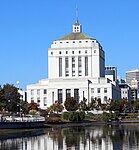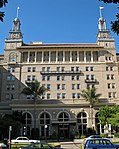Oakland Museum of California
1960s architecture in the United States1969 establishments in CaliforniaArt museums and galleries in CaliforniaEducation in Oakland, CaliforniaGardens in California ... and 6 more
History museums in CaliforniaInstitutions accredited by the American Alliance of MuseumsModernist architecture in CaliforniaMuseums established in 1969Museums in Oakland, CaliforniaNatural history museums in California

The Oakland Museum of California or OMCA (formerly the Oakland Museum) is an interdisciplinary museum dedicated to the art, history, and natural science of California, located adjacent to Oak Street, 10th Street, and 11th Street in Oakland, California. The museum contains more than 1.8 million objects dedicated to "telling the extraordinary story of California."
Excerpt from the Wikipedia article Oakland Museum of California (License: CC BY-SA 3.0, Authors, Images).Oakland Museum of California
Oak Street, Oakland
Geographical coordinates (GPS) Address External links Nearby Places Show on map
Geographical coordinates (GPS)
| Latitude | Longitude |
|---|---|
| N 37.7986 ° | E -122.2636 ° |
Address
Oakland Museum of California (OMCA)
Oak Street 1000
94607 Oakland
California, United States
Open on Google Maps







